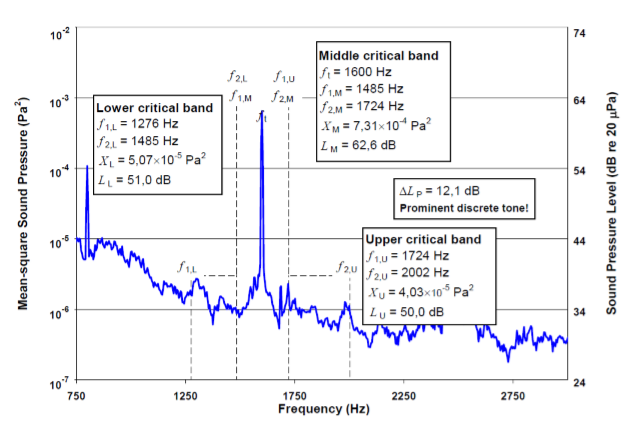Prominence Ratio
The Prominence Ratio (PR) computation is detailed in both ECMA-418-1 (former ECMA 74 Annex D) and ISO7779:1999 standards. It is applicable for tones whose frequencies stand between 89.1 and 11 220 Hz.
Sound: Analysis and Specification provides an automatic tone detection procedure from the signal’s spectrum (with a resolution around one Hz), which is not part of the standards that only define the calculation of PR at a given frequency. The procedure is therefore used prior to the computation of the Prominence Ratio per se.
In Sound: Analysis and Specification, the Prominence Ratio (PR) is included in Tonality computation profile. You may also calculate the PR of an order and display it as a curve of PR versus RPM or time.
For a given frequency ft, the Prominence Ratio is computed as the ratio between:
the energy of the critical band centered at ft (energy XM between f1,M and f2,M on the figure below), and
the mean of the energies of the two adjacent bands (energy XU between f1,U and f2,U for the upper band, and energy XL between f1,L and f2,L for the lower band).

If the tone frequency is higher than 171.4 Hz, the PR is computed according to the following formula:
10lg [XM /(XL + XU) * 0.5]
If the peak frequency is lower than 171.4 Hz, the lower critical band is narrower and its energy is therefore weighted. The PR is then computed according to the following formula:
10lg [XM /{[XL * (100/ DƒL )] + XU } * 0.5]
A tone is considered as prominent if:
PR > 9 dB for ft > 1000 Hz
PR > 9 + 10 log (1000/ft) dB for ft ≤ 1000 Hz.
Two outputs/results are available for the Prominence Ratio computation:
The Prominence ratio (dB) curve over the frequency scale. The Prominence ratio value is displayed for each detected tone. The threshold for considering that a given tone is prominent (as defined above) is also displayed as a blue curve.
The Detailed Prominent Ratio results, which is an information window displaying the following data:
Signal name
Sampling frequency
Time limits of the analysis
Maximal Prominence Ratio on the signal
Calculation details for each detected tone (tone frequency, Prominence ratio, tone level, tone bandwidth around the tone, and ratio between the tone bandwidth and critical bandwidth).


